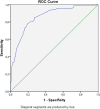Predicting the risk for lymphoma development in Sjogren syndrome: An easy tool for clinical use
- PMID: 27336863
- PMCID: PMC4998301
- DOI: 10.1097/MD.0000000000003766
Predicting the risk for lymphoma development in Sjogren syndrome: An easy tool for clinical use
Abstract
The heightened risk of non-Hodgkin lymphoma (NHL) development in primary Sjogren syndrome (SS) is well established. Several adverse clinical and laboratory predictors have been described. In the current work, we aimed to formulate a predictive score for NHL development, based on clinical, serological, and histopathological findings at the time of SS diagnosis. In the present case-control study of 381 primary SS patients and 92 primary SS patients with concomitant NHL, clinical, serological, and histopathological variables at the time of SS diagnosis were retrospectively recorded. For the identification of predictors for NHL development univariate and multivariate models were constructed. Salivary gland enlargement (SGE), lymphadenopathy, Raynaud phenomenon, anti-Ro/SSA or/and anti-La/SSB autoantibodies, rheumatoid factor (RF) positivity, monoclonal gammopathy, and C4 hypocomplementemia were shown to be independent predictors for NHL development. On the basis of the number of independent risk factors identified, a predictive risk score for NHL development was formulated. Thus, patients presenting with ≤2 risk factors had a 3.8% probability of NHL development, those with 3 to 6 risk factors 39.9% (OR (95%CI): 16.6 [6.5-42.5], P < 0.05), while in the presence of all 7 risk factors the corresponding probability reached 100% (OR [95%CI]: 210.0 [10.0-4412.9], P < 0.0001). In conclusion, an easy to use diagnostic scoring tool for NHL development in the context of SS is presented. This model is highly significant for the design of early therapeutic interventions in high risk SS patients for NHL development.
Conflict of interest statement
The authors have no funding and conflicts of interest to disclose.
Figures



References
-
- Voulgarelis M, Dafni UG, Isenberg DA, et al. Malignant lymphoma in primary Sjogren's syndrome: a multicenter, retrospective, clinical study by the European Concerted Action on Sjogren's syndrome. Arthritis Rheum 1999; 42:1765–1772. - PubMed
-
- Zintzaras E, Voulgarelis M, Moutsopoulos HM. The risk of lymphoma development in autoimmune diseases: a meta-analysis. Arch Intern Med 2005; 165:2337–2344. - PubMed
-
- Solans-Laque R, Lopez-Hernandez A, Bosch-Gil JA, et al. Risk, predictors, and clinical characteristics of lymphoma development in primary Sjogren's syndrome. Semin Arthritis Rheum 2011; 41:415–423. - PubMed
Publication types
MeSH terms
Substances
LinkOut - more resources
Full Text Sources
Other Literature Sources
Medical
Research Materials
Miscellaneous

